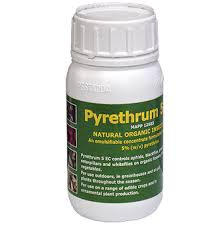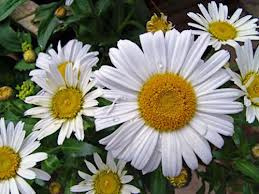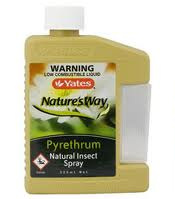
Origin
Pyrethrum is also the name of a natural insecticide made from the dried flower heads of Chrysanthemum cinerariifolium and Chrysanthemum coccineum.
Family: Asteraceae
Scientific name
Chrysanthemum cinerariaefolium, C. coccineum, C. marshalli, Tanacetum cinerariifolium
Active Constituents
Pyrethrum Extract is a mixture of three naturally occurring, closely related insecticidal ester of chrysanthemic acid (cinerin I, jasmolin I and pyrethrin I) and three closely related insecticidal ester of pyrethric acid (cinerin II, jasmolin II and pyrethrin II).
The three chrysanthemic acid esters are commonly identified as “pyrethrins I”, and the three pyrethric acid esters are identified as “pyrethrins II”. Collectively, the six esters are called “pyrethrins”
Uses
Pyrethrum was used for centuries as an insecticide
Pyrethrum is also the name of a natural insecticide made from the dried flower heads of Chrysanthemum cinerariifolium and Chrysanthemum coccineum.
Family: Asteraceae
Scientific name
Chrysanthemum cinerariaefolium, C. coccineum, C. marshalli, Tanacetum cinerariifolium
Active Constituents
Pyrethrum Extract is a mixture of three naturally occurring, closely related insecticidal ester of chrysanthemic acid (cinerin I, jasmolin I and pyrethrin I) and three closely related insecticidal ester of pyrethric acid (cinerin II, jasmolin II and pyrethrin II).
The three chrysanthemic acid esters are commonly identified as “pyrethrins I”, and the three pyrethric acid esters are identified as “pyrethrins II”. Collectively, the six esters are called “pyrethrins”
Uses
Pyrethrum was used for centuries as an insecticide

Pharmaceutical Prepration
Pyrethrum is used in two ways: as a powder or dust and as a spray.
Pyrethrum powder:
Grind flowers to a dust. Use pure or mix with a carrier like talc, lime or diatomaceous earth (DE). Sprinkle over infested plants. Py-mack can be used in a similar manner.
Pyrethrum spray:
1. Mix 20 g pyrethrum powder with 10 litres water. Soap can be added to make the substance more effective but it is not vital. Strain and apply immediately as a spray. For best effects this should be applied in the evening.
2. The active ingredients can also be extracted by alcohol. Mix one cup powdered pyrethrum flowers with1/8 cup of isopropyl alcohol (the blue alcohol used in house cleaning) or kerosene. Cover the container and let it sit overnight. Strain through a clean cotton cloth, then store the extract in a tightly sealed and a labelled container. When you need to use it, add 3 litres of water to the extract and spray.
3. Dofour preparation (for large scale spraying): 1 to 1.5 kg dried pyrethrum is mixed into 100 litres of water and 3 litres of liquid dish soap. Strain and spray. The addition of soap is supposed to increase the efficacy four-fold.
References
·
Casida, J. E. and G. B. Quistad, (Eds). (1995). Pyrethrum Flowers' Production, Chemistry, Toxicology, and Uses. Oxford University Press, Oxford
*Casida, J. E., (Ed.) (1973). Pyrethrum, The Natural Insecticide. Academic Press, New York. Cox, C. (2002). Pyrethrins/Pyrethrum Insecticide Factsheet. Journal of Pesticide Reform 22(1) 14-20.
·Cornell University. Ressource guide to organic insect management. www.nysaes.cornell.edu
·Ellis B.W. and Bradley, F.M. (1992). The Organic Gardener's Handbook of Natural Insect and Disease Control. Rodale Press 1992. ISBN:0-87596-753-1
*Herb Herbert Fact Sheet on Pyrethrum: www.herbherbert.com
·OISAT:Online Information Service for Non-Chemical Pest Management in the Tropics. www.oisat.org
·Plants For a Future Database: Pyrethrum. www.pfaf.org
·Stoll, G. (1988). Natural Crop Protection in the Tropics. CTA publication from AGRECOL, Switzerland.
WAS THIS INFORMATION USEFUL?
Pyrethrum is used in two ways: as a powder or dust and as a spray.
Pyrethrum powder:
Grind flowers to a dust. Use pure or mix with a carrier like talc, lime or diatomaceous earth (DE). Sprinkle over infested plants. Py-mack can be used in a similar manner.
Pyrethrum spray:
1. Mix 20 g pyrethrum powder with 10 litres water. Soap can be added to make the substance more effective but it is not vital. Strain and apply immediately as a spray. For best effects this should be applied in the evening.
2. The active ingredients can also be extracted by alcohol. Mix one cup powdered pyrethrum flowers with1/8 cup of isopropyl alcohol (the blue alcohol used in house cleaning) or kerosene. Cover the container and let it sit overnight. Strain through a clean cotton cloth, then store the extract in a tightly sealed and a labelled container. When you need to use it, add 3 litres of water to the extract and spray.
3. Dofour preparation (for large scale spraying): 1 to 1.5 kg dried pyrethrum is mixed into 100 litres of water and 3 litres of liquid dish soap. Strain and spray. The addition of soap is supposed to increase the efficacy four-fold.
References
·
Casida, J. E. and G. B. Quistad, (Eds). (1995). Pyrethrum Flowers' Production, Chemistry, Toxicology, and Uses. Oxford University Press, Oxford
*Casida, J. E., (Ed.) (1973). Pyrethrum, The Natural Insecticide. Academic Press, New York. Cox, C. (2002). Pyrethrins/Pyrethrum Insecticide Factsheet. Journal of Pesticide Reform 22(1) 14-20.
·Cornell University. Ressource guide to organic insect management. www.nysaes.cornell.edu
·Ellis B.W. and Bradley, F.M. (1992). The Organic Gardener's Handbook of Natural Insect and Disease Control. Rodale Press 1992. ISBN:0-87596-753-1
*Herb Herbert Fact Sheet on Pyrethrum: www.herbherbert.com
·OISAT:Online Information Service for Non-Chemical Pest Management in the Tropics. www.oisat.org
·Plants For a Future Database: Pyrethrum. www.pfaf.org
·Stoll, G. (1988). Natural Crop Protection in the Tropics. CTA publication from AGRECOL, Switzerland.
WAS THIS INFORMATION USEFUL?


 RSS Feed
RSS Feed